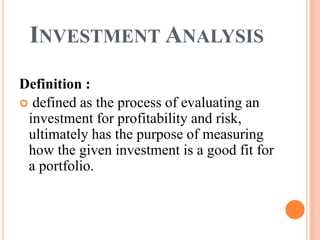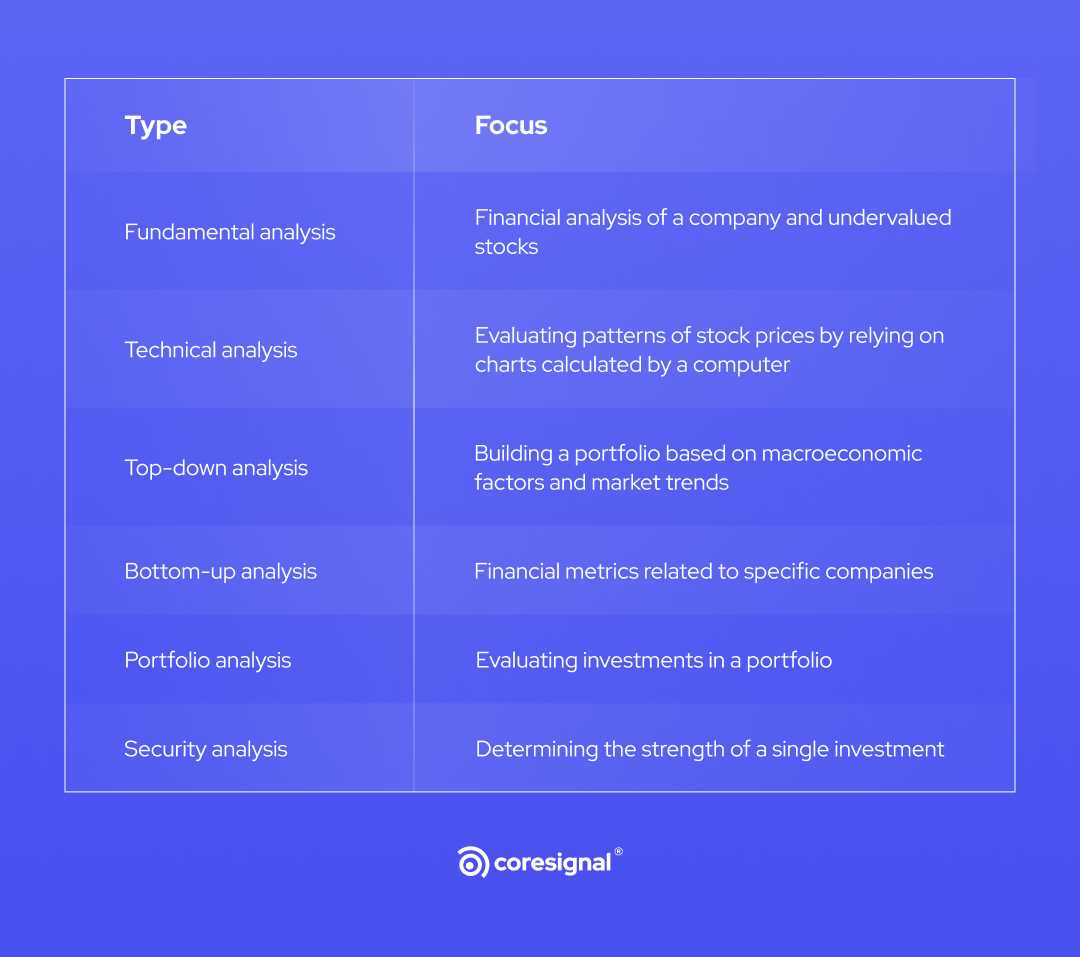Definition of Investment Analysis

Investment analysis is a crucial process in the field of finance that involves evaluating the potential risks and returns of an investment opportunity. It is a systematic approach used by investors to make informed decisions about allocating their financial resources.
Investment analysis involves gathering and analyzing relevant financial information, such as historical data, market trends, and company financial statements. This information helps investors assess the financial health and performance of an investment, as well as its potential for growth and profitability.
Importance of Investment Analysis
Investment analysis plays a crucial role in the decision-making process for investors. It helps investors understand the potential risks and rewards associated with an investment opportunity, allowing them to make informed decisions based on their financial goals and risk tolerance.
By conducting thorough investment analysis, investors can identify undervalued assets or opportunities for growth, which can lead to higher returns on investment. It also helps investors diversify their portfolios by identifying investments that have low correlation with each other, reducing the overall risk of their portfolio.
Furthermore, investment analysis helps investors monitor the performance of their investments and make necessary adjustments to their portfolio. It provides a framework for evaluating the success or failure of an investment strategy and allows investors to make informed decisions about buying, selling, or holding investments.
Types of Investment Analysis
Investment analysis is a crucial process that helps investors make informed decisions about where to allocate their funds. There are various types of investment analysis methods that investors can utilize to evaluate potential investment opportunities. Each type of analysis provides a different perspective and focuses on different aspects of the investment.
1. Fundamental Analysis
Fundamental analysis is a method of investment analysis that involves evaluating the intrinsic value of a security or asset. It examines various factors such as financial statements, industry trends, competitive advantages, and management quality to determine the true value of an investment. This type of analysis is commonly used by long-term investors who are interested in the underlying fundamentals of a company or asset.
2. Technical Analysis
Technical analysis is a method of investment analysis that focuses on studying historical price and volume data to predict future price movements. It utilizes charts, patterns, and indicators to identify trends and patterns in the market. Technical analysts believe that historical price data can provide insights into the future direction of prices and help them make profitable trading decisions.
3. Quantitative Analysis
Quantitative analysis is a method of investment analysis that involves using mathematical and statistical models to evaluate investment opportunities. It utilizes data such as financial ratios, historical performance, and market trends to quantify the risk and return of an investment. This type of analysis is commonly used by quantitative investors and hedge funds to identify undervalued assets and generate alpha.
4. Qualitative Analysis
Importance of Investment Analysis
Investment analysis plays a crucial role in the financial decision-making process. It helps individuals and organizations make informed investment choices, manage risk, and maximize returns. Here are some key reasons why investment analysis is important:
1. Risk Management
Investment analysis helps in assessing and managing risks associated with different investment options. By analyzing various factors such as market trends, economic conditions, and industry performance, investors can identify potential risks and take appropriate measures to mitigate them. This helps in safeguarding their investments and reducing the chances of financial losses.
2. Maximizing Returns
Investment analysis enables investors to identify investment opportunities that have the potential to generate higher returns. By analyzing the financial performance, growth prospects, and valuation of different investment options, investors can make informed decisions that can lead to higher profitability. It helps in optimizing the investment portfolio and maximizing returns on investment.
3. Strategic Planning
Investment analysis helps in strategic planning by providing insights into the market and industry trends. It helps investors understand the current market conditions, anticipate future changes, and align their investment strategies accordingly. This allows investors to make proactive decisions and stay ahead of the competition.
4. Diversification

Investment analysis helps in diversifying the investment portfolio by identifying different investment options across various asset classes. By analyzing the risk-return profile of different investments, investors can allocate their funds in a way that reduces the overall risk and increases the potential for returns. Diversification helps in spreading the investment risk and achieving a balanced portfolio.
5. Long-Term Financial Planning
Investment analysis is essential for long-term financial planning. It helps individuals and organizations set realistic financial goals, determine the required rate of return, and develop a comprehensive investment strategy. By analyzing the investment options and their potential returns, investors can align their investments with their long-term financial objectives and ensure financial stability in the future.
Portfolio Management and Investment Analysis
Portfolio management and investment analysis are two closely related concepts that play a crucial role in the world of finance. While portfolio management focuses on the overall management of an investment portfolio, investment analysis is the process of evaluating the potential risks and returns of individual investments.
Portfolio managers are responsible for making investment decisions on behalf of their clients or organizations. They conduct thorough research and analysis to identify investment opportunities and make informed decisions about buying, selling, or holding investments. They also monitor the performance of the portfolio and make necessary adjustments to ensure it remains aligned with the investor’s objectives.
Importance of Investment Analysis
Investment analysis is a critical component of portfolio management. It involves evaluating the potential risks and returns of individual investments to make informed investment decisions. By conducting investment analysis, portfolio managers can assess the financial health of companies, analyze market trends, and identify investment opportunities that align with the investor’s objectives.
Investment analysis helps investors make informed decisions about buying or selling securities. It involves analyzing financial statements, conducting industry research, and evaluating the competitive landscape to determine the intrinsic value of an investment. This analysis helps investors identify undervalued or overvalued securities, which can lead to profitable investment opportunities.
Role of Investment Analysis in Portfolio Management
Investment analysis is an integral part of portfolio management. It provides portfolio managers with the necessary information to make informed investment decisions and manage the portfolio effectively. By conducting investment analysis, portfolio managers can assess the risk-return profile of individual investments and determine their suitability for inclusion in the portfolio.
Investment analysis also helps portfolio managers monitor the performance of the portfolio and make necessary adjustments. By analyzing the performance of individual investments, portfolio managers can identify underperforming assets and take appropriate actions, such as selling or replacing them with better-performing alternatives.
| Benefits of Investment Analysis in Portfolio Management |
|---|
| 1. Risk Management: Investment analysis helps portfolio managers identify and manage investment risks, ensuring the portfolio remains within the investor’s risk tolerance. |
| 2. Performance Evaluation: Investment analysis allows portfolio managers to evaluate the performance of individual investments and the overall portfolio, helping them make informed decisions about portfolio rebalancing. |
| 3. Diversification: Investment analysis helps portfolio managers identify investment opportunities across different asset classes, allowing for diversification and reducing the overall risk of the portfolio. |
| 4. Maximizing Returns: By conducting investment analysis, portfolio managers can identify undervalued securities and investment opportunities that have the potential to generate higher returns. |

Emily Bibb simplifies finance through bestselling books and articles, bridging complex concepts for everyday understanding. Engaging audiences via social media, she shares insights for financial success. Active in seminars and philanthropy, Bibb aims to create a more financially informed society, driven by her passion for empowering others.
